Hold down the T key for 3 seconds to activate the audio accessibility mode, at which point you can click the K key to pause and resume audio. Useful for the Check Your Understanding and See Answers.
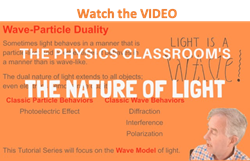 An age-old debate that has persisted among scientists is related to the question, "Is light a wave or a stream of particles?" Very noteworthy and distinguished physicists have taken up each side of the argument, providing a wealth of evidence for each side. The fact is that light exhibits behaviors that are characteristic of both waves and particles. In this unit of The Physics Classroom Tutorial, the focus will be on the wavelike nature of light.
An age-old debate that has persisted among scientists is related to the question, "Is light a wave or a stream of particles?" Very noteworthy and distinguished physicists have taken up each side of the argument, providing a wealth of evidence for each side. The fact is that light exhibits behaviors that are characteristic of both waves and particles. In this unit of The Physics Classroom Tutorial, the focus will be on the wavelike nature of light.
Light exhibits certain behaviors that are characteristic of any wave and would be difficult to explain with a purely particle-view. Light reflects in the same manner that any wave would reflect. Light refracts in the same manner that any wave would refract. Light diffracts in the same manner that any wave would diffract. Light undergoes interference in the same manner that any wave would interfere. And light exhibits the Doppler effect just as any wave would exhibit the Doppler effect. Light behaves in a way that is consistent with our conceptual and mathematical understanding of waves. Since light behaves like a wave, one would have good reason to believe that it might be a wave. In Lesson 1, we will investigate the variety of behaviors, properties and characteristics of light that seem to support the wave model of light. On this page, we will focus on three specific behaviors - reflection, refraction and diffraction.
A wave doesn't just stop when it reaches the end of the medium. Rather, a wave will undergo certain behaviors when it encounters the end of the medium. Specifically, there will be some reflection off the boundary and some transmission into the new medium. The transmitted wave undergoes refraction (or bending) if it approaches the boundary at an angle. If the boundary is merely an obstacle implanted within the medium, and if the dimensions of the obstacle are smaller than the wavelength of the wave, then there will be very noticeable diffraction of the wave around the object. Each one of these behaviors - reflection, refraction and diffraction - is characterized by specific conceptual principles and mathematical equations. The reflection, refraction, and diffraction of waves were first introduced in Unit 10 of The Physics Classroom Tutorial. In Unit 11 of The Physics Classroom Tutorial, the reflection, refraction, and diffraction of sound waves was discussed. Now we will see how light waves demonstrate their wave nature by reflection, refraction and diffraction.
Reflection of Light Waves
All waves are known to undergo reflection or the bouncing off of an obstacle. Most people are very 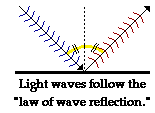 accustomed to the fact that light waves also undergo reflection. The reflection of light waves off of a mirrored surface results in the formation of an image. One characteristic of wave reflection is that the angle at which the wave approaches a flat reflecting surface is equal to the angle at which the wave leaves the surface. This characteristic is observed for water waves and sound waves. It is also observed for light waves. Light, like any wave, follows the law of reflection when bouncing off surfaces. The reflection of light waves will be discussed in more detail in Unit 13 of The Physics Classroom. For now, it is enough to say that the reflective behavior of light provides evidence for the wavelike nature of light.
accustomed to the fact that light waves also undergo reflection. The reflection of light waves off of a mirrored surface results in the formation of an image. One characteristic of wave reflection is that the angle at which the wave approaches a flat reflecting surface is equal to the angle at which the wave leaves the surface. This characteristic is observed for water waves and sound waves. It is also observed for light waves. Light, like any wave, follows the law of reflection when bouncing off surfaces. The reflection of light waves will be discussed in more detail in Unit 13 of The Physics Classroom. For now, it is enough to say that the reflective behavior of light provides evidence for the wavelike nature of light.
Refraction of Light Waves
All waves are known to undergo refraction when they pass from one medium to another medium. That is, when a wavefront crosses the boundary between two media, the direction that the wavefront is moving undergoes a sudden change; the path is "bent." This behavior of wave refraction can be described by 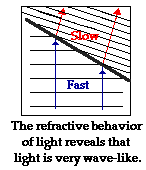 both conceptual and mathematical principles. First, the direction of "bending" is dependent upon the relative speed of the two media. A wave will bend one way when it passes from a medium in which it travels slowly into a medium in which it travels fast; and if moving from a fast medium to a slow medium, the wavefront will bend in the opposite direction. Second, the amount of bending is dependent upon the actual speeds of the two media on each side of the boundary. The amount of bending is a measurable behavior that follows distinct mathematical equations. These equations are based upon the speeds of the wave in the two media and the angles at which the wave approaches and departs from the boundary. Light, like any wave, is known to refract as it passes from one medium into another medium. In fact, a study of the refraction of light reveals that its refractive behavior follows the same conceptual and mathematical rules that govern the refractive behavior of other waves such as water waves and sound waves. The refraction of light waves will be discussed in more detail in Unit 14 of The Physics Classroom Tutorial. For now, it is enough to say that the refractive behavior of light provides evidence for the wavelike nature of light.
both conceptual and mathematical principles. First, the direction of "bending" is dependent upon the relative speed of the two media. A wave will bend one way when it passes from a medium in which it travels slowly into a medium in which it travels fast; and if moving from a fast medium to a slow medium, the wavefront will bend in the opposite direction. Second, the amount of bending is dependent upon the actual speeds of the two media on each side of the boundary. The amount of bending is a measurable behavior that follows distinct mathematical equations. These equations are based upon the speeds of the wave in the two media and the angles at which the wave approaches and departs from the boundary. Light, like any wave, is known to refract as it passes from one medium into another medium. In fact, a study of the refraction of light reveals that its refractive behavior follows the same conceptual and mathematical rules that govern the refractive behavior of other waves such as water waves and sound waves. The refraction of light waves will be discussed in more detail in Unit 14 of The Physics Classroom Tutorial. For now, it is enough to say that the refractive behavior of light provides evidence for the wavelike nature of light.
Diffraction of Light Waves
Reflection involves a change in direction of waves when they bounce off a barrier. Refraction of waves involves a change in the direction of waves as they pass from one medium to another. And diffraction involves a change in direction of waves as they pass through an opening or around an obstacle in their path. Water waves have the ability to travel around corners, around obstacles and through openings. Sound waves do the same. But what about light? Do light waves bend around obstacles and through openings? If they do, then it would provide still more evidence to support the belief that light behaves as a wave.
When light encounters an obstacle in its path, the obstacle blocks the light and tends to cause the formation of a shadow in the region behind the obstacle. Light does not exhibit a very noticeable ability to bend 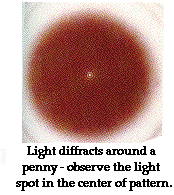 around the obstacle and fill in the region behind it with light. Nonetheless, light does diffract around obstacles. In fact, if you observe a shadow carefully, you will notice that its edges are extremely fuzzy. Interference effects occur due to the diffraction of light around different sides of the object, causing the shadow of the object to be fuzzy. This is often demonstrated in a Physics classroom with a laser light and penny demonstration. Light diffracting around the right edge of a penny can constructively and destructively interfere with light diffracting around the left edge of the penny. The result is that an interference pattern is created; the pattern consists of alternating rings of light and darkness. Such a pattern is only noticeable if a narrow beam of monochromatic light (i.e., single wavelength light) is passed directed at the penny. The photograph at the right shows an interference pattern created in this manner. Since, light waves are diffracting around the edges of the penny, the waves are broken up into different wavefronts that converge at a point on a screen to produce the interference pattern shown in the photograph. Can you explain this phenomenon with a strictly particle-view of light? This amazing penny diffraction demonstration provides another reason why believing that light has a wavelike nature makes cents (I mean "sense"). These interference effects will be discussed in more detail later in this lesson.
around the obstacle and fill in the region behind it with light. Nonetheless, light does diffract around obstacles. In fact, if you observe a shadow carefully, you will notice that its edges are extremely fuzzy. Interference effects occur due to the diffraction of light around different sides of the object, causing the shadow of the object to be fuzzy. This is often demonstrated in a Physics classroom with a laser light and penny demonstration. Light diffracting around the right edge of a penny can constructively and destructively interfere with light diffracting around the left edge of the penny. The result is that an interference pattern is created; the pattern consists of alternating rings of light and darkness. Such a pattern is only noticeable if a narrow beam of monochromatic light (i.e., single wavelength light) is passed directed at the penny. The photograph at the right shows an interference pattern created in this manner. Since, light waves are diffracting around the edges of the penny, the waves are broken up into different wavefronts that converge at a point on a screen to produce the interference pattern shown in the photograph. Can you explain this phenomenon with a strictly particle-view of light? This amazing penny diffraction demonstration provides another reason why believing that light has a wavelike nature makes cents (I mean "sense"). These interference effects will be discussed in more detail later in this lesson.
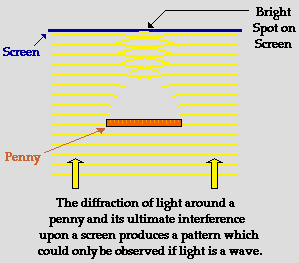
Light behaves as a wave - it undergoes reflection, refraction, and diffraction just like any wave would. Yet there is still more reason to believe in the wavelike nature of light. Continue with Lesson 1 to learn about more behaviors that could never be explained by a strictly particle-view of light.